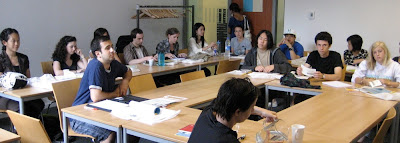
Walking past Anne Frankstraat and the Esnoga, the Portugese-Sephardic synagogue dating back to the late 1600s, we first visited the Jewish Historical Museum in the heart of the old Jewish quarter of Amsterdam. During our time at the museum, which used to house four synagogues (known as the Ashkenazi Synagogue Complex), we were able to get a glimpse into the history of Dutch Jewry from the 17th until the 20th century. Besides viewing historical material from these time periods--material that shed light on integral historic figures like Baruch Spinoza, Menasse ben Israel, Shabtai Tsvi-- we had the chance to view the synagogues from these time periods, since, as previously stated, they have come to physically form the present museum. The oldest synagogue in the complex, known as the Great Shul, was built in 1671. As the community dramatically grew during the late 17th and 18th centuries, three other synagogues were built in quick succession – the Obbene Shul (1686-1688), the Dritt Shul (1700) and the Neie Shul (1730, expanded in 1750). Each former synagogue now houses different galleries of the museum. For example, the galleries in the New Shul focus on the topic of Dutch Jewish life in the 20th century. The Great Shul features the exhibition on Jewish religion and tradition, as well galleries that highlight the history of the Jews of the Netherlands from the beginning of the 17th century till the end of the 19th century. The themes of these two sections of the museum, i.e. the past and present, are encapsulated by the following quote from the JHM website: “The stories about the first Jews to come to the Netherlands, about assimilation and integration, cultural interchange with non-Jews and the preservation of their Jewish identity are themes that remain topical today in contemporary situations and debates.”


After the museum tour, we walked a few blocks to another building, which is also considered part of the JHM, the Hollandsche Schouwburg (Dutch Theater). This theater was used as a deportation center for Jews during WWII. The theatre, built in 1892, used to be the entertainment center of the Jewish quarter. During the war, however, its function completely changed and it was used to send thousands of people to the Westerbork transit camp in Holland, and from there to the extermination camps where over 100,000 Dutch Jews were killed. The theater became a memorial in 1962. Its auditorium has been replaced by an open courtyard with an obelisk where the stage once stood. The entrance hall leads into a memorial room where an eternal flame burns. Next to the flame, there is a wall on which family names of all the Jews from the Netherlands who perished during the Second World War are engraved. Before leaving the Dutch Theater, we were given a lecture on how the events of World War II affected people living in the Netherlands.


Feeling like I could not get a full sense of the old Jewish quarter in Amsterdam without visiting the Esnoga, I went back to this part of town a few days later. After visiting the massive construction, I learned that it was built in 1671 by the ‘crypto-Jews’ of Portugal--Jews who fled to Portugal after the expulsion of 1492 and were forcibly converted to Catholicism in 1496 but were still persecuted because of their luminal status. Over a century later, with discrimination and persecution still rampant, many of these conversos, who were still secretly practicing Judaism, fled northwards and found refuge in Amsterdam. These refugees often called themselves Portuguese Jews to avoid being identified with Spain, which was at war with the Netherlands at the time. Within a few decades, they set up a bourgeoning community in their new place of residence and were able to enjoy the kinds of benefits that most Jews in Europe could not, since they were still predominantly relegated to impoverished ghettos. Thus, because of financial and social liberties, they were able to have a very massive synagogue built in central Amsterdam. Its magnitude and grandeur can only be truly felt after one goes inside the main sanctuary.



The synagogue also houses the oldest functioning Jewish library in the world, Ets Haim Bibliotheek, which has been in the Esnoga since 1675. The following quote from the library’s website puts the library into an interesting Sephardic-Jewish context: “By integrating rather than assimilating into their new environment, Spanish-Portuguese Jews often played an important role in transferring scientific knowledge from the Islamic world to Christian Europe. This openness is mirrored in the Ets Haim's policy of providing a thorough grounding in Jewish scholarship combined with excellent tutoring in secular subjects like literature, philosophy and the natural sciences. This mixed curriculum contributed greatly to a society where different religions coexisted.” And with this quote, I would like to end my blog entry because the blurb nicely introduces some issues that Emily and I will be investigating on this trip, primarily: the boundaries and unique attributes of Dutch-Jewish identity, the interaction with non-Jewish society in Amsterdam.

